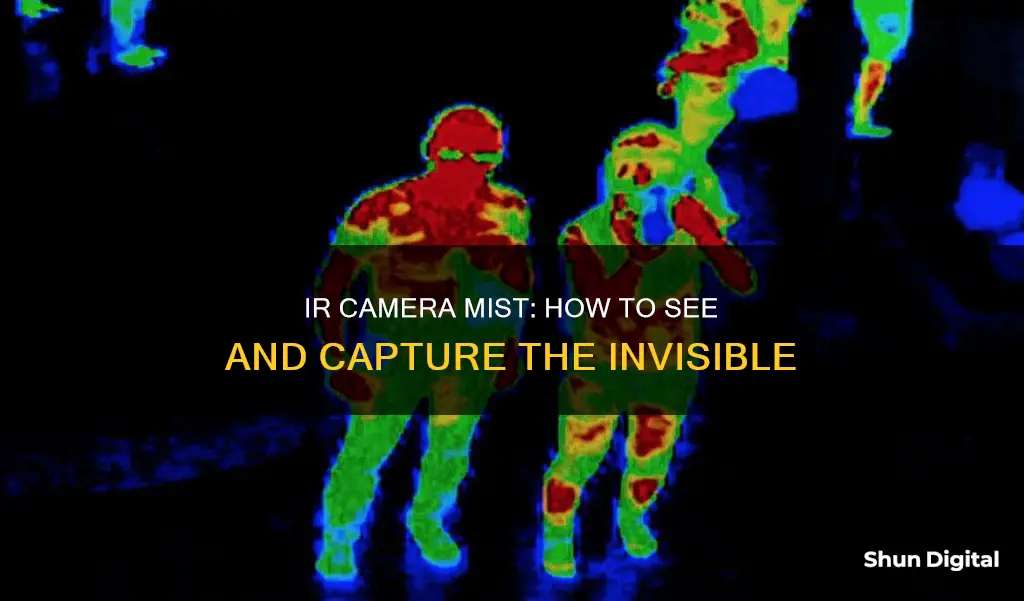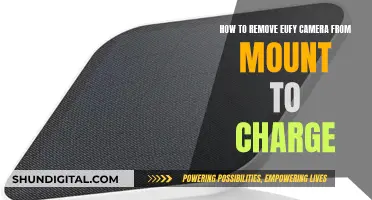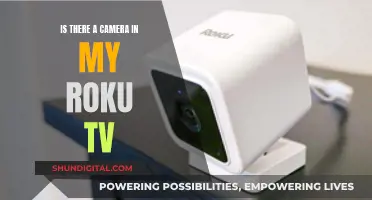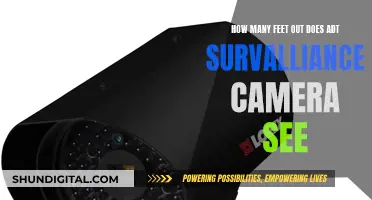
Thermal imaging cameras are an excellent tool for night vision applications, as they can produce clear images in total darkness without the need for any light. However, their performance in adverse weather conditions, such as mist, fog, or rain, is a frequently asked question. While thermal imaging cameras can see through light mist, their range is affected by atmospheric conditions. Humid air, for example, acts as a shield for infrared radiation, reducing the distance that a thermal imaging camera can see. Additionally, mist or fog can cause light to scatter, further diminishing the infrared signal. To improve performance in misty conditions, it is recommended to use a thermal imaging camera with a wiper or install a housing to protect the camera from the elements.
What You'll Learn
- IR cameras can see through light fog, light rain, and snow
- Humid air acts as a shield for infrared radiation
- The higher the density of water droplets, the more the infrared signal is diminished
- The range of an IR camera is affected by the size of the target
- IR cameras are excellent for night vision applications

IR cameras can see through light fog, light rain, and snow
The performance of IR cameras in such conditions depends on several factors, including the type of camera, the wavelength of infrared light used, and the density of water droplets in the atmosphere. For example, IR cameras with cooled detectors, which operate at cryogenic temperatures, are more sensitive to small temperature differences and can provide clearer images in foggy or rainy conditions.
The scattering of light off water droplets in the atmosphere can impact the performance of IR cameras. This scattering effect is more pronounced in dense fog or heavy rain, where the higher density of water droplets results in a more significant reduction in the infrared signal. However, in light fog, light rain, or snow, IR cameras can still capture clear images by transmitting and receiving the infrared signal through these atmospheric conditions.
The type of infrared camera and the wavelength of light it operates within are also important factors. IR cameras typically operate in the longwave infrared (LWIR) band, which has better performance in foggy conditions compared to the midwave infrared (MWIR) band. Additionally, the size of the target and the temperature difference between the target and the background can influence the effectiveness of IR cameras in low-visibility conditions.
Overall, while IR cameras can see through light fog, light rain, and snow, the specific performance will depend on various factors, including the camera technology, atmospheric conditions, and target characteristics.
Troubleshooting Guide: Raspi-Config Camera Option Missing
You may want to see also

Humid air acts as a shield for infrared radiation
Water vapour absorbs well in the infrared region of the electromagnetic spectrum. Humid air acts as a "shield" for infrared radiation, with summer months having a higher attenuation compared to winter months due to increased humidity levels.
Humid air exposed to IR radiation has been found to have several effects on the physicochemical properties of water. One study found that treatment with IR radiation helped to partially protect enzymes from heat inactivation, mixed function oxidation, and loss of activity due to partial unfolding.
Another study found that IR radiation promoted the formation of exclusion zones (EZ) at the interfaces between hydrophilic surfaces and water. EZ-water properties differ significantly from that of bulk water. After treatment of tested aqueous systems with humid air exposed to IR radiation, their properties change, making them more like EZ-water.
The results suggest that IR irradiation of humid air converts it into a carrier of a certain physical signal that affects water properties.
B-Link Camera Security: Who's Watching via Web Browser?
You may want to see also

The higher the density of water droplets, the more the infrared signal is diminished
Infrared cameras are excellent instruments for night vision applications. They can see in total darkness, producing clear, crisp images without the need for any light. However, the distance an infrared camera can see is affected by various factors, including atmospheric conditions.
Fog, for example, can severely limit the range of a thermal imaging system due to the scattering of light off droplets of water. The higher the density of water droplets in the fog, the more the infrared signal is diminished. This is because the scattering of light increases as the density of the water droplets increases, making it harder for the infrared signal to travel from the target to the camera.
The impact of fog on infrared signal transmission depends on the size of the water droplets that make up the fog. Smaller droplets scatter light in a way that is more detrimental to the infrared signal. This is because smaller droplets have a higher scattering efficiency, which means that they are more effective at scattering light in all directions.
In addition to the size of the droplets, the wavelength of the infrared light also plays a role in how much the signal is diminished. Infrared light in the mid-infrared and longwave infrared bands is more affected by scattering from water droplets than infrared light in the shortwave infrared band.
To improve the performance of infrared cameras in foggy conditions, it is important to consider the camera's specifications, such as the lens being used, the sensitivity of the detector, and the waveband in which the camera operates. Cameras with cooled detectors, for example, tend to be more sensitive to small temperature differences and can provide better images in foggy conditions.
Furthermore, the type of fog and the climate can also impact the performance of infrared cameras. For example, maritime fog can result in lower detection ranges compared to fog in other climates due to the larger particle radii of maritime aerosols.
Overall, while infrared cameras are useful tools for night vision and seeing through fog, their effectiveness can be limited by the density of water droplets in the air.
WebOS TV: Built-in Camera Convenience?
You may want to see also

The range of an IR camera is affected by the size of the target
The range of an IR camera is affected by several factors, including the size of the target object, the lens being used, the sensitivity of the camera, and the temperature of the target and its background.
The larger the target, the easier it is for the IR camera to detect it, as a bigger object will reflect more IR light back to the camera. This is especially important when trying to measure the temperature of an object. The Spot Size Ratio (SSR) or Distance:Size Ratio (D:S ratio) is a key metric to understand here. This ratio tells you how far you can be from a target of a given size and still get an accurate temperature reading. The formula for SSR is:
SSR = Distance / Spot Size
For example, an IR camera with an SSR of 36:1 can measure an object as small as 1 foot at 36 feet away, or 1 meter at 36 meters away. So, the bigger the target, the higher the distance can be while still maintaining the same ratio and achieving an accurate temperature reading.
It's important to note that the resolution of the camera also plays a role in detecting objects. A camera with higher resolution will provide more pixels on the target, improving accuracy even at a distance. Additionally, a narrow field of view will magnify distant objects, further enhancing accuracy.
When trying to detect or measure a target with an IR camera, it is crucial to ensure that the target is not too small or too far away, as this can compromise the accuracy of the readings.
Furthermore, atmospheric conditions, such as fog and rain, can also impact the range of an IR camera. These conditions can affect the scattering and absorption of infrared radiation, reducing the distance at which objects can be detected.
Big Brother Through Your Device's Camera?
You may want to see also

IR cameras are excellent for night vision applications
IR cameras are ideal for night-time surveillance as they can see in total darkness, producing clear, crisp images without the need for any light. This makes them perfect for monitoring buildings or other assets after dark, and they are often used by police officers, security guards, and rescuers. They are also popular among hunters, fishermen, and videographers. IR cameras can be used to identify offenders, record criminal activity, and quickly detect attempts to penetrate secure facilities or private property.
The benefit of IR cameras is that they are hard to spot. As they use infrared light, which is invisible to the human eye, they do not give away their position. This is in contrast to colour night vision, which uses visible light sources to illuminate the area. IR cameras are also more covert than colour night vision as they do not rely on visible white light. However, a downside of IR cameras is that they produce black-and-white footage.
IR cameras can be used in a variety of settings, both indoors and outdoors. When choosing an IR camera, it is important to consider the specific application and choose a camera with the appropriate lens and zoom capacity. For example, a camera with a wide field of view is recommended for monitoring a large front lawn or backyard. On the other hand, indoor cameras typically require a shorter night vision range or adjustable infrared intensity to avoid creating glare from reflective surfaces. It is also important to consider the illumination distance of the camera, as lower-quality cameras may only brighten objects a few feet away.
In addition to standard IR cameras, there are also thermal imaging cameras, which form an image based on the detected heat signatures of objects. These cameras are particularly useful in foggy or rainy conditions, as they can detect thermal radiation through various obstacles. However, it is important to note that the distance a thermal imaging camera can see is affected by atmospheric conditions, with summer months generally resulting in shorter ranges due to higher humidity levels.
Unifi Camera Remote Viewing: Easy Setup Guide
You may want to see also
Frequently asked questions
IR cameras are able to see through mist, fog, and haze. However, the distance that can be seen is affected by atmospheric conditions.
The range of an IR camera is influenced by factors such as the lens being used, the sensitivity of the camera, the size of the object being detected, and the temperature of the target and background.
Humid air acts as a shield for infrared radiation, reducing the range of the IR camera. Summer months typically have higher humidity levels, resulting in increased attenuation compared to winter months.
Fog can severely limit the range of an IR camera due to the scattering of light off water droplets. The denser the fog, the more the infrared signal is diminished.







